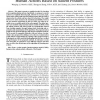7 search results - page 1 / 2 » A characterization of triangle-free tolerance graphs |
DAM
2006
13 years 4 months ago
2006
We prove that a triangle-free graph G is a tolerance graph if and only if there exists a set of consecutively ordered stars that partition the edges of G. Since tolerance graphs a...
CCS
2009
ACM
14 years 5 months ago
2009
ACM
In this paper, we re-visit the problem of unconditionally secure message transmission (USMT) from a sender S to a receiver R, who are part of a distributed synchronous network, mo...
TCSV
2008
13 years 4 months ago
2008
This paper presents a graphical model for learning and recognizing human actions. Specifically, we propose to encode actions in a weighted directed graph, referred to as action gra...
WIOPT
2010
IEEE
13 years 3 months ago
2010
IEEE
—In this paper we study the influence of using hub nodes to relay messages in human-based delay tolerant networks (DTNs), by analyzing empirical traces obtained by human mobilit...
SIAMDM
2010
13 years 3 months ago
2010
Graph theory has been used to characterize the solvability of the sensor network localization problem. If sensors correspond to vertices and edges correspond to sensor pairs betwee...

